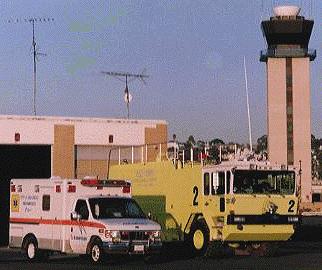Paramedic Rescue Unit 63



rev. 01-21-97 ver.2
Paramedic Rescue Unit 63 has been assigned to Lindbergh Field, San Diego International Airport for almost four years. We are stationed at the Airport Fire Station and share quarters with the Crash and Rescue trucks otherwise known as Aircraft Rescue and Fire Fighting Rescue Units (A.R.F.F.) per F.A.A. guidelines. All together we have 4 "crash trucks" and one ambulance. There is over one million dollars worth of apparatus on the station floor. The crash trucks are staffed and maintained by The San Diego Fire Department. We work closely with the fire crews on incidents involving aircraft of course and with the San Diego Harbor Police officers and outside San Diego Fire Dept. units on medical aids.

It is very slow here for paramedicine and this assignment is not for everyone. We sometimes get very sick people that happen to become ill in the terminal or on a plane in flight. We have had everything from minor ankle injuries to Traumatic Cardiac Arrest. We average 2 responses per day. Approximately 35,000 to 45,000 people pass through this terminal a day and Linbergh field is the busiest single runway airport in the United States. A plane is landing or taking off sometimes within a period of 45 seconds. Approximately 250 passenger aircraft land per day and another 250 takeoff. Also, there are 5 cargo aircraft landings and 5 takeoffs per day. Due to noise restrictions, there are no takeoffs between 12:00 midnight and 06:00 am. Currently the terminal is expanding and will soon be able to carry a higher volume of traffic. At pressent there is a "commuter terminal," and two main terminals with 30 gates. Eight more gates are being added and afterwards another 8 in the near future. There are currently 20 passenger carriers and 5 cargo services operating here. The access roadways are also being upgraded and a new state of the art, modern control tower is now complete. The airport was opened in August 1928 with one runway (27-9) and another one added (13-31) soon after. Runway 27-9 is now 9,600 feet and 13-31 is a taxi way. San Diego is a large city with access to many other countries via its airport, however most airlines use Linbergh field as a termination or transfer point.

Every once and awhile we have an
"alert" which usually turns out to be nothing more than a malfunctioning
light or something benign. However, we have had wheel brake fires, large
fuel spills, smoke on board, hydraulic failures, nose gear or landing gear
failures, tire blow-outs ("flats") and engine burn or flame outs. There is
always the possibility of a large scale incident with multiple patients or the
threat terroristic activities. Alerts are structured as 2, 3 or 4. Alert 2 is
an impending problem with an inbound plane or helicopter. Alert 3 is a "crash!"
And, alert 4 is a "Bomb Threat!" We have to be prepared and ready 24 hours a
day.

 |
 |
We have just three minutes to get to a "crash site or incident" from the time the alarm sounds.

Additional Training:

There was some additional training for paramedics assigned here, like an extensive review of the Disaster Plan (Annex-D) which follows along the same algorithm as the State Fire Chiefs plan (incident command structure) for large scale incidents. But, most of the specific training included orientation to the Airport Operations Area or A.O.A. We also took basic classes from the control tower supervisors which involved orientation and observation to Air Traffic Controlling. This included I.L.S. (instrument landing systems) usage, glide slope, radio traffic, and emergency procedures. Delta Airlines recently gave us an extensive class on aircraft rescue and evacuation which included classroom and practical time. We did have to pass a very thorough background check to become assigned here: And, take a few test. But, a prerequisites is a State licensed, County Accredited, Department of Motor Vehicle Certified, Department of Transportation qualified; Paramedic Certificate with all the other certificates and qualifications that come with it like A.C.L.S. and P.A.L.S.

As you can see, this station has some disadvantages, like being comitted to the Airport and not being allowed off the field unless we are transporting. It can be very boring and monotonous. But, it is an exciting place to be at when we are needed and our skills are put to test. This is a very dyamic place and even running a routine "medical aid" can be challenging...
Hopefully we will never have to use our advanced training!
Thanks for having interest in our page.

More Crash and Rescue Airport Fire Stations can be found
here:
The
Aviation Fire Journal

 The Beginning |
 Navigation |
S.D. Dispatch |
S.D. Paramedics |
S.D. MedNews On-Line |
E.K.G. |
 LINKS |
Public Safety |
Magic Wand |
Web page design and maintenance by Mitch Mendler E.M.T. Paramedic FireFighter;The WebMaster!
All aspects of this page are copyright © 1996 the San Diego Paramedics & or S.D.C.P.A. and unless otherwise stated are property of the San Diego Paramedics, and or the San Diego County Paramedic Association and or the San Diego Dispatch Center.